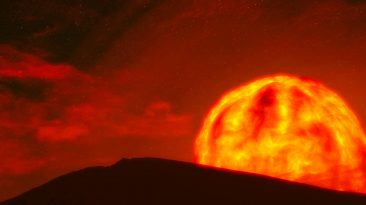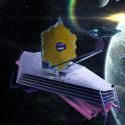What’s the best place to put solar panels? Close to the Sun, of course. And in this scenario, we’re going to build the most efficient solar farm possible. And maybe, just maybe, that would make us a Type II civilization on the Kardashev scale. What would a Sun-orbiting solar farm look like? How close would we be able to get the panels to our star? And how would we manage to get all that power back to Earth?
Every second, the Sun produces more energy than we humans have used in the history of humankind. And every 90 minutes, the Earth receives enough sunlight to power humanity for a full year. Only we’re still far from gathering even a fraction of all that energy. In 2021, of all the electricity we generated, only 3.1% came from solar panels.
Even if we built more solar farms here on Earth, not all of the Sun’s energy would reach us. Our star is radiating energy in all directions. And not all of the light that hits Earth even makes contact with our planet’s surface. Some of it is reflected or absorbed by our atmosphere and clouds. Considering how much energy is lost before the sunlight even reaches the solar farms down on Earth, it would be more efficient to get our solar panels somewhere they could face the Sun 24 hours a day, every day.
But would this increased efficiency come at the cost of cooking all life on Earth from the inside out? If you really wanted to maximize our solar power potential, you’d need to start with building a lot of panels. Solar panels are made of photovoltaic cells, or PV cells, that convert sunlight into electricity. And approximately 95% of the modules sold today are made of silicone.
Unfortunately, you’d have to manufacture these cells on Earth before bringing your solar panels into space. That transportation would cost a pretty penny. To save on expenses, you’d want to build your solar panels with the lightest materials possible. One idea would be to make your solar cells with lightweight gallium arsenide.
With this material, you could build individual solar cells each about the size of your dinner plate. Once you carried them into the Earth’s orbit, you’d put them together in blocks as large as 60 sq m (645 sq ft). That’s about the size of four parking lots. With a good supply of solar panels, you could now start planning their arrangement around the Sun. One model you could explore would be a Dyson sphere.
That’s a gigantic megastructure we could engineer around the Sun. The scientist who came up with this idea actually stole it (pause) from aliens. He theorized that a much more advanced alien civilization built this hollow sphere around their star to gather all of its energy. So if those theoretical aliens could rearrange their planetary neighborhood like that, we could do it too, right?
Did I mention this Dyson sphere would have to be gigantic? The distance around the Sun, or its circumference, is about 4.4 million km (2.7 million mi). So we would need millions, if not billions, of individual solar panels to hug our Sun. Our Dyson sphere would need to be a little further from the Sun so that it wouldn’t touch its scorching hot surface. In other words, the gigantic megastructure would have to be larger than the Sun itself.
Well, maybe instead of building such an impossibly massive structure, you could send a bunch of solar panels that would independently orbit the Sun. Over time, more and more solar panels could be added to create larger, more complex structures. Surely there’s no way the materials you used to build your solar panels could get anywhere near the Sun without completely melting. Right? Think again.
NASA’s Parker Solar Probe traveled through the Sun’s corona layer and heated up to 1,400 °C (2,550 °F). Impressive, but that’s frigid compared to the temperature of the corona itself. It gets as toasty as millions of degrees in there. Yeah, you wouldn’t be able to get that close to the Sun unless humanity came up with lots of super-heat-resistant materials. Forget about that. But you could build solar power stations a little further from the Sun.
Maybe somewhere halfway between it and the Earth. You’d still be able to receive enormous amounts of power from there. Theoretically, if your space solar power station was 10 sq km (4.9 sq mi), it could power 1.5 million homes. On Earth’s surface, you’d need about six million solar panels to generate the same amount of energy.
Speaking of supplying Earth with power, how exactly would you manage to get all that energy back to our planet so we could use it? Your power transmission system would have to be wireless. And that would mean using microwave radiation. You’d need to build massive antennae. Your space solar farm would send microwaves back to Earth, and here, we’d turn them into electricity.
These antennae would take up a lot of land but they’d become your favorite scenic view. Of course, you could strengthen the microwave signal from your solar farm and use smaller antennae to catch it on Earth. But this would come at a higher risk. Microwave radiation could heat your body tissue the same way it heats food in a microwave. That means a strong enough microwave signal would cause painful burns.
It could even cook you from the inside out. And not just you. Microwave radiation would roast anything containing water. Oceans, lakes and rivers could start to boil. If water reservoirs below the Earth’s crust heated up enough, the internal pressure could result in the whole planet exploding. If you could get around these terrifying downsides, putting solar panels in space would be a huge advancement for our civilization.
It could even be a step up on the Kardashev scale. This measures how advanced a civilization is based on the usable energy it can produce. Right now, we’re ranked as a Type 0 civilization because we don’t even collect all of the energy from our planet. If we were able to harness all the power of the Sun through a Dyson sphere or solar panels orbiting it, we’d jump up to a Type II civilization.
That means we’d have more energy than we could even imagine right now. Interstellar travel beyond our Solar System would become a real possibility. But we’d have to become a Type I civilization first.
Sources
- “How Does The Sun Produce Energy?”. Fraser Cain. 2015. phys.org.
- “How Much Energy Does The Sun Produce?”. 2022. learnastronomyhq.com.
- “Energy and Ecosystems – Use Some Lose Some”. 2022. web.extension.illinois.edu.
- “A Solar Panel In Space Is Collecting Energy That Could One Day Be Beamed To Anywhere On Earth”. Nick Walsh. 2021. ctvnews.ca.
- “What Is Earth’S Energy Budget? Five Questions With A Guy Who Knows”. 2022. nasa.gov.



























